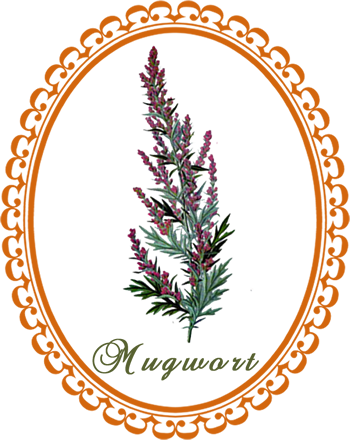
Mugwort: is a valuable digestive tonic; its bitterness stimulates the appetite and helps in the breakdown of fats ...
Common Names: Mugwort, Artemis Herb, Artemisia, Sailors Tobacco
Botanical Name: Artemisia vulgaris
Family: Asteraceae
Plant Type: Perennial
Parts Used: Leaves, roots
Flowering: August, September
Part of the wormwood family, mugwort is native to Europe, Asia, and the Mediterranean region.
Description: The bushy plant grows to a height of 2 - 8 feet with angular, often purple hued stems. The smooth, deeply lobed leaves are dark green on the upper surface and covered with a dense cottony down on the underside. Mugwort has spikes of small reddish, yellow or white flowers.
Cultivation: Mugwort grows best in light, dry and well-drained soil in full sun. Sow seeds in spring, or take cuttings in late summer.
Harvesting: Collect the leaves in August and dig the root in autumn. Cleanse the roots in cold water and free then from the rootlets. Spread thinly on clean shelves in a warm room for about ten days, turning frequently. When the roots are somewhat shrunken, accelerate the drying process with artificial heat until the roots are dry to the core and brittle, snapping when bent.
Culinary Uses: Mugwort was once used as a bitter for flavoring beer, but has been superseded by hops (Humulus lupulus). It is a seasoning in some cuisines, although it has somewhat fallen into disuse in many countries because of a toxic compound (thujone) found in the plant. Mugwort is used in Korea and Japan to flavor rice cakes, soups and other dishes. In Europe, it is applied as a bitter herb to season roast goose.
Mugwort Magick
Strength. Psychic Powers. Protection. Prophetic Dreams. Healing. Astral Projection.
Gender: Feminine
Planet: Venus
Element: Earth
Deities: Artemis, Diana
Place mugwort near your bed to help facilitate astral projection.
Use an infusion of mugwort to wash crystal balls and magic mirrors.
Burn mugwort with sandalwood or wormwood during scrying rituals.
Place mugwort in your shoes to gain strength during long walks or runs.
Sleep on a pillow stuffed with mugwort leaves to receive prophetic dreams.
Place some mugwort leaves beneath or around a crystal ball to aid in psychic workings.
Herbal Healing with Mugwort
Medicinal Actions: Abortifacient, analgesic, anthelmintic, anti-inflammatory, antirheumatic, antispasmodic, aperitif, aperitive, carminative, cholagogue, diaphoretic, digestive, diuretic, emmenaogue, febrifuge, insect repellent, nervine, purgative (mild), regulator (menstrual cycle), sedative, stimulant (uterine), sudorific, tonic (uterine), vermifuge
Medicinal Uses: Mugwort has been a traditional remedy for worms however, the dosage needed to expel worms may be quite high, and can lead to purging, which can be very unpleasant - it is not recommended to use it in this way without professional guidance. The ability of mugwort to break down fats makes it very useful for people who have gall-bladder problems, or who have had their gall bladders removed. It combines well with dandelion root (Taraxacum radix), yellow dock (Rumex crispus) and licorice (Glycyrrhiza glabra). Its other virtue as a bitter is to increase appetite and promote digestion.
In the reproductive system, mugwort regulates female cycles; it is used to bring on the onset of menstruation, and also used to warm the womb and stop bleeding where the cycle is prolonged.
Mugwort can relieve fatigue and stimulate the nervous system, and helps in the treatment of depression and low spirits when used with herbs such as St. John's wort (Hypericum), oats (Avena), or verbena (Verbena).
In traditional Chinese medicine, the downy leaves are used to make moxa, which is burned near the skin to raise vital energy in that area. The down is separated by heating the leaves and afterwards rubbing them between the hands until the cottony fibres remain; these are then made up into small cones or cylinders for use. This is beneficial for many rheumatic and muscular conditions. If used on specific acupuncture points, it can be used to help turn breech babies in the womb.
Contraindications:
- Do not use mugwort during pregnancy.
- Prolonged use can cause injury to the nervous system.
- Do not exceed the dosage, as it contains a toxic substance called thujone, which can build up in the body.
Preparation and Dosage:
Tincture: 1 - 2 ml (20 - 40 drops) twice daily
Infusion: 100 ml (4 oz) twice daily
The Chinese use a dose of 1/8 to ½ ounce per day.
Native American Herb Wisdom
Native Americans used the leaves medicinally in decoctions for colds, colic, bronchitis, rheumatism, and fever. Safe for suppressed menstruation, also effective in female complaints of various nature when combined with marigold (Calendula), crampbark (Viburnum opulus), black haw (Viburnum prunifolium), and mint (Mentha). It was also used in kidney and bladder inflammations and their many reflected ailments, gout, sciatica, water retention, etc.
Source: A Handbook of Native American Herbs by Alma R. Hutchens
If you appreciate the information provided,
please help keep this website running. Blessings!
© 2008-2025 aromaworx.ca. All rights reserved.

